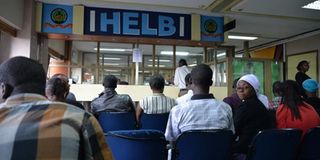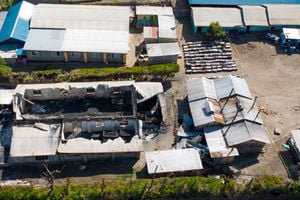Helb a godsend for Kenyan college students

Applicants visit Helb offices in Nairobi. Most students in institutions of higher learning depend on Helb for tuition and upkeep expenses.
What you need to know:
- Most students in institutions of higher learning depend on Helb for tuition and upkeep expenses.
- In the academic year 2020/2021, the number of loan applicants decreased by 3.2 per cent to 376,137 from 388,683 in 2019/2020.
- The loans awarded fell 6.6 per cent to Sh14.2 billion in 2020/2021, from Sh15.2 billion in 2019/2020.
Education can be quite expensive but with the use of the Higher Education Loans Board (Helb) loans, there is a smarter way to finance studies.
Most students in institutions of higher learning depend on Helb for tuition and upkeep expenses.
However, it comes out as a disappointment to other students who fail to receive the loan after application for various reasons—such as failure to get correct bank details.
In some cases, it depends on the government’s delay in releasing funds to Helb.
That makes learning a bad experience for freshmen, who need to apply for a loan for the first time, very difficult.
Some end up deferring courses to seek alternative ways of financing their education.
Helb remains a great financial aid to students in institutions of higher learning.
In the academic year 2020/2021, the number of loan applicants decreased by 3.2 per cent to 376,137 from 388,683 in 2019/2020.
That might have been caused by a decline in the number of students, who were joining technical and vocational education and training (TVET) centres, which reduced from 135,046 to 114,737 in the 2019/2020 and 2020/2021 academic years.
The loans awarded fell 6.6 per cent to Sh14.2 billion in 2020/2021, from Sh15.2 billion in 2019/2020.
Beneficiary data by gender shows more males than females applied for the loans.
This is because of an increase in the number of male applicants from public universities, which rose by 2.5 per cent from 128,321 in 2019/20 to 131,478 in 2020/21.
The female loan applicants decreased by 1.3 per cent and stood at 85,962 from 87,075 previously.
Private university students embraced the loan more, owing to a recorded 15 per cent growth of applicants—from 38,241 in 2019/2020 to 43,960 in 2020/2021.
That was attributed to the government’s enrolment of more students for degree courses in private universities.
The government puts in more effort to aid students in TVET institutes undertaking technical and vocational courses through provision of Helb loans. In 2020/2021, the amount of loan beneficiaries in TVETs amounted to 105,826, an increase from 102,111 in 2019/2020.
The loans awarded in higher institutions in 2019/2020 were Sh15,210.3 million while Sh14,207.1 million was granted in 2020/2021, totalling more than Sh19 billion.
This trend showed a 34.2 per cent increase.
According to the statistics above, which are drawn from the Kenya National Bureau of Statistics (KNBS), it becomes evident that the government plays a crucial role in supporting the education sector of students in higher institutions of learning through Helb financing.
Electine Ometa, Nairobi




